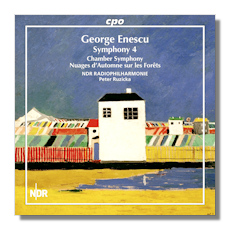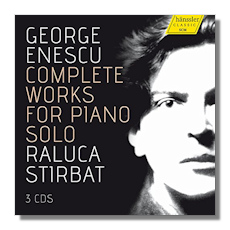
The Internet's Premier Classical Music Source
Related Links
- Enescu Reviews
- Latest Reviews
- More Reviews
-
By Composer
-
Collections
DVD & Blu-ray
Books
Concert Reviews
Articles/Interviews
Software
Audio
Search Amazon
Recommended Links
Site News
 CD Review
CD Review
George Enescu

Late Orchestral Works
- Symphony #4 in E minor (1934, completed by Pascal Bentoiu)
- Symphonic Suite "Nuages d'Automne sur les Forêts" (1939)
- Chamber Symphony, Op. 33 (1954)
NDR Radiophilharmonie Hannover/Peter Ruzicka
CPO 777966-2


Complete Works for Piano Solo
- Sonata for Piano in D Major, Op. 24 #3 (1935)
- Sonata for Piano in F Sharp minor, Op. 24 #1 (1924)
- Sonantensatz in F Sharp minor (1912)
- Suite #1 "dans le style ancien" in G minor, Op. 3 (1897)
- Suite #2 "Les Cloches Sonores" in D Major, Op. 10 (1903)
- Suite #3 "Pièces impromptues", Op. 18 (1897)
- Barcarolle in B Flat Major (1897)
- Impromptu in A Flat Major (1898)
- Impromptu in C Major (1900)
- Nocturne in D Flat Major (1907)
- Pièce sur le nom de Fauré (1922)
- Prélude & Scherzo in F Sharp minor (1896)
- Prélude & Fugue in C Major (1900)
- La Fileuse in D Major (1897)
- Regrets in G Flat Major (1898)
Raluca Stirbat, piano
Hänssler 98.060 3CDs
The Romanian composer and musician George Enescu had an extraordinary effect on his musical contemporaries. He was a student at the Paris Conservatoire with Ravel, who described him as "the most skilled among all of us with Gedalge" (who taught composition). Pablo Casals described him as "the greatest musical phenomenon since Mozart", while Enescu's student Yehudi Menuhin declared that "Enescu gave me the light that has guided my entire existence". Nowadays he is a relatively neglected figure, probably best known for his two Romanian Rhapsodies, which are perfectly agreeable but probably not what Ravel, Casals, and Menuhin were talking about.
This 3-CD set from Hänssler Classic of Raluca Stirbat playing Enescu's complete music for solo piano and CPO's release of the Symphony #4 and two other orchestral works will help open eyes to the scope and originality of Enescu's compositions. It is telling that this is the first ever recording of the Symphony #4 (which, admittedly, Enescu left unfinished), and there are a number of other firsts among the solo piano works. Yet, almost all of the pieces reveal a composer with a distinctive voice and innovative approaches to harmony and structure, and some of them deserve a place in the standard twentieth-century repertoire.
The principal highlights from these discs are the Symphony #4 and the Chamber Symphony. The Symphony #4 receives its world première recording from Peter Ruzicka and the NDR Radiophilharmonie. It was sketched out in full by the composer, but only the first of the three movements was completely instrumented. Musicologist Pascal Bertiou completed the instrumentation in 1996. Enescu considered himself to be primarily a symphonist, and this symphony reveals him to as a very fine orchestral colorist with a distinctive harmonic voice and sense of structure. The slow movement is particularly striking, opening with a funeral march on the horn with hand drum accompaniment. The march slowly gives way to fragmented melodies in an exotic harmonic universe, leading to a seamless transition to the final movement – largely sunny in mood, but with flashbacks to the slow movement.
The Chamber Symphony occupies a similar sound world to the opening of the last movement of the Symphony #4. It was Enescu's final work, composed when he was in very poor health. Particularly memorable is the sense of intimate dialog between distinct melodic lines, as well as the funeral march in the third movement. This is a very concentrated and focused work.
The three CDs of Enescu's piano music are more or less chronologically ordered. Enescu was a noted child prodigy, completing his course of study at the Vienna Conservatory by the age of 14. The works on the first CD were almost all written before his 20th birthday. None of the pieces are masterpieces, but most bear the distinctive stamp of the composer – rhythmically in the A flat major Impromptu (with the unusual time signature of 15/16) and harmonically in the Barcarolle. Enescu's neo-classical leanings are also prominent. The Op. 3 Suite, written when Enescu was 16, has an impressive neo-Baroque fugue, and the 1903 Prelude and Fugue incorporates a distinctive blend of late Romantic harmonies and expressiveness.
As Enescu's career progressed his Baroque leanings receded more into the background. Compare the Op. 10 Suite with its predecessor, for example – there are echoes of Debussy and Ravel in the Pavane, and the bell motif plays an important structural role (the piece is subtitled "Les Cloches Sonores"). Also on CD2 we have Nocturne, which offers a very good introduction to Enescu's sound world, and Pièces Impromptus, composed in 1913-1916 but lost until 1957. Two are particularly striking – the haunting and ghostly Mazurk Mélancolique and the shimmering sounds of the Carillon Nocturne.
The principal offerings on CD3 are the two late sonatas. 24 #1, dating from 1924, and #3, written 11 years later. (Enescu never got beyond the preliminary sketches for #2.) The disc opens with the 1912 Sonatensatz, which was the first version of the Allegro from Sonata #1. This piece, lost until 1993, has a very late Romantic musical idiom, and sprawls somewhat. The later version in the sonata is much more focused and less generic. It has a pronounced folk element, although not as much as the second movement Presto Vivace, which has very strong and percussive rhythms, or the Andante molto, which sounds like a sort of folk nachtmusik. The Sonata #3 is, to my ear, the most completely satisfying of Enenscu's works for piano. The outer movements combine late Romanticism with Enescu's Romanian melodies and harmonies, framing a haunting slow movement.
Both of these issues do an invaluable service in bringing Enescu to the attention of a modern audience. Not everything here is gold, but there are certainly some gems. Raluca Stirbat, the distinguished Romanian pianist, is clearly wonderfully well attuned with Enescu's musical voice. Likewise Peter Ruzicka and the NRD Radiophilharmonie. The sound and recording quality is uniformly high.
Copyright © 2015, José Luis Bermúdez





















